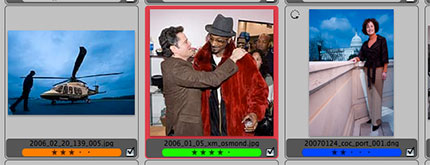Upgrades, Upgrades, Upgrades
 Every once in awhile, I get caught off guard. Such was the case Friday. At the conclusion of an assignment where I had produced 10GB of images for a corporate client, over five seperate 2GB cards, I returned to my office, and we began to ingest the images. I made the mistake of popping open the back door of the camera while the camera was still on. A rare oversight on my part, I am usually very methodical about this seemingly small point. This time, however, when the card was mounted, it showed no files.
Every once in awhile, I get caught off guard. Such was the case Friday. At the conclusion of an assignment where I had produced 10GB of images for a corporate client, over five seperate 2GB cards, I returned to my office, and we began to ingest the images. I made the mistake of popping open the back door of the camera while the camera was still on. A rare oversight on my part, I am usually very methodical about this seemingly small point. This time, however, when the card was mounted, it showed no files.
Frustrated, I knew the additional work involved in rescuing the card. I've done it before more times than I wish I'd have to, but it's really not a cause for alarm, because I have yet to be unable to recover a clients files from a CF card. Had this happened on assignment, I immediately stop using the card, and isolate it for attention back in the office. In this case, we were already there.
I launched Photo Rescue, my go to solution for recovering files (in this case, both RAW and JPEG). I know that Lexar and SanDisk have their software, and I'm sure they work fine, but I know that I have not only saved my own files before with Photo Rescue, but have also saved friends cards where others have failed. In fact, PC Magazine rated it the best of several products. I won't go into details about imaging the card first, and so on, but I will say that there was a problem.
The program recovered the JPEG's, but the CR2 files were showing up as TIF's, and I know that's a problem. Of course, I panicked. This was about 6pm, and the folks in my office were talking about arrangements for leaving for the day. I said over my shoulder "you're going to leave me here with this problem unresolved?" There didn't seem to be much compassion for my predicament, and soon I and my corrupt card were all alone in the office, and my wife was calling on the phone asking me about meeting her downtown for dinner. "When I get to a point where I can resolve this problem, dear", was my message back to her.
So I thought. And I contemplated. Then I realized that there might be another solution. Enter my trusted friend, v3.0. You see, I had v2.1, and while it had served it's master well, it was time to take retirement. I looked up my date of purchase, and it was outside of the free window for a complimentary upgrade, and the only link on the site was for the full version, at $29.99, but not for the $19.99 upgrade price. So, I downloaded the free demo, and ran the card (actually, the image of the card) through the recovery software, and - voila! My JPEGs and my CR2's. Whew! Then I click the "Next" button, and am met with "To save your images, enter your registration key".
Enter my trusted friend, v3.0. You see, I had v2.1, and while it had served it's master well, it was time to take retirement. I looked up my date of purchase, and it was outside of the free window for a complimentary upgrade, and the only link on the site was for the full version, at $29.99, but not for the $19.99 upgrade price. So, I downloaded the free demo, and ran the card (actually, the image of the card) through the recovery software, and - voila! My JPEGs and my CR2's. Whew! Then I click the "Next" button, and am met with "To save your images, enter your registration key".
I went to the site, and, seeing that I could only e-mail the site's owners for upgrade information, and knowing it was Friday night, thinking that unlikely, and beyond that, considering that they are located in Belgium, while I sent the e-mail, I opted to go through the automated process of obtaining the full version. I waited, and waited. And then I left for dinner.
When I returned at 9pm, there was an e-mail from Belgium providing a link to the upgrade page, and also telling me to pay there. By 11pm I had my upgrade with serial #, and a refund for my full version, and my images were safely saved on my redundant hard drives, converted to both DNG and JPEG, and I could go to sleep - a restful one at that.
Make sure you have the latest upgrades to your critical software. Software upgrades like those for Photo Mechanic include dual processor support, background processes, full IPTC compliance, and tabbed browsing: ![]() as well as full implementation of both the star-rating and color-class, adding to their valuable tagged/untagged system to mark your selected images, as seen below:
as well as full implementation of both the star-rating and color-class, adding to their valuable tagged/untagged system to mark your selected images, as seen below: In addition, it handles the latest RAW files, and includes a year's upgrades. At $150 for first time buyers, it's the fastest solution for editing images (especially on location), and upgrading with a year's additional upgrades is only $90.
In addition, it handles the latest RAW files, and includes a year's upgrades. At $150 for first time buyers, it's the fastest solution for editing images (especially on location), and upgrading with a year's additional upgrades is only $90.
Spending the time upgrading your software, and the costs to do so, is just one more reason why your post production charges are a critical part of your billability as a photographer. Doing so on a schedule, rather than on a panicked Friday night, will give you more peace of mind. I type this as a peaceful man, but if it weren't for the Belgians being so responsive at 11pm EST, I'd be panicked all weekend long. Thanks guys!
Please post your comments by clicking the link below. If you've got questions, please pose them in our Photo Business Forum Flickr Group Discussion Threads.
 Everyone's complaining about how clients are demanding WMFH contracts, and legal departments seem everywhere to want that language in their contracts. Ok, put it in, and have it apply when you are paid an appropriate fee (as deemed by you), and you agree, specifically, to it in writing.
Everyone's complaining about how clients are demanding WMFH contracts, and legal departments seem everywhere to want that language in their contracts. Ok, put it in, and have it apply when you are paid an appropriate fee (as deemed by you), and you agree, specifically, to it in writing. And have contemplated a myriad of circumstances, from the Geographic's "
And have contemplated a myriad of circumstances, from the Geographic's "